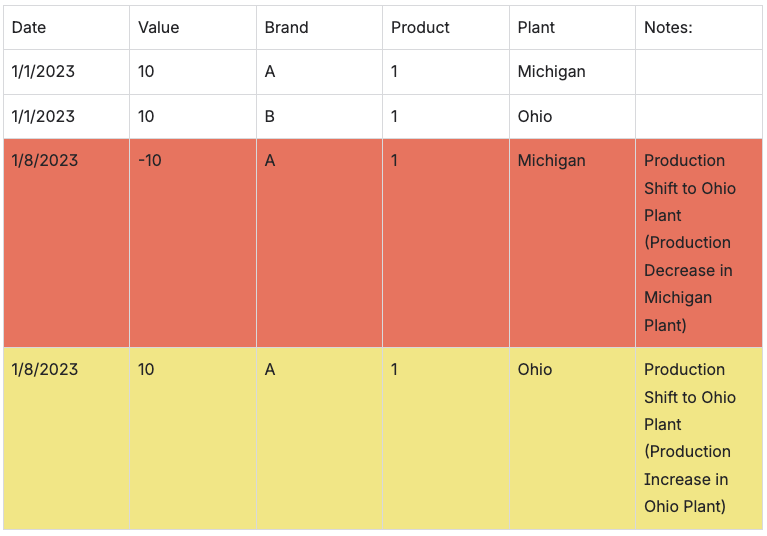Production Shifts and Cancelled Orders: Demand Forecasting
There may be instances when working on a demand planning use case in SensibleAI Forecast where the demand dataset will include cancelled orders or production shifts. This article provides a couple of helpful tips on how to remedy those items in the dataset.
Problem Statement
There could be scenarios when a stakeholder’s datasets have cancelled orders or production shifts included in their demand datasets. An example of this is on a weekly level dataset where one of the days has an order of 10 units, and then a week later those 10 units are subtracted or have a negative value. Furthermore, an entirely different plant may have those 10 units added. Mathematically that makes sense, but when trying to forecast true demand, it begins to confuse SensibleAI Forecast. So, the question becomes this: what can we do to ensure that we capture the true level of demand?

Why do Production Shifts Occur?
Production shifts in manufacturing can occur for various reasons, but outlined below are a handful of scenarios illustrating why they may happen.
-
Demand Fluctuations: Changes in customer demand can require adjustments to production schedules to meet the customer needs.
-
Supply Chain Disruptions: Issues like raw material shortages, supplier delays or transportation problems can cause a company to shift production.
-
Operational Efficiency: Manufacturers may alter production schedules to optimize resource utilization, reduce costs, or improve overall efficiency in the supply chain.
-
Regulatory Changes: Updates in regulations or standards may require companies to alter production practices to comply with new regulations.
Overall, production shifts are a natural part of manufacturing operations and will be something that consultants will run into when implementing SensibleAI Forecast. Now, in the next section we will talk about a couple of ways to remediate those Production Shifts in datasets.
Remediation Strategies
- Adjust Historical Data
This approach is to adjust historical data to account for cancelled orders and production shifts. This can involve taking a snapshot of the dataset that is in the past to create an accurate historical dataset.
- Incorporate Events
The incorporation of features/events allows the SensibleAI Forecast models to understand when production shifts are occurring. Learning from history that demand increases when a “Production Increase or Production Decrease” event is present could help yield accuracy in the models.
This technique doesn’t justify the dataset, but does help SensibleAI Forecast understand when large production shifts are occurring and how to react.
- Remove Cancelled Orders and Production Shifts
One option is to simply remove the entries related to cancelled orders and production shifts from the dataset. This approach can provide a dataset that reflects only the confirmed and fulfilled demand. However, be cautious as this may lead to underestimating the actual demand in the long run.
Stakeholder Communication
Develop a communication strategy for stakeholders to transparently convey how cancellations and production shifts are being handled in the dataset. Clearly communicate the rationale behind the chosen approach and its implications for decision-making.
This is incredibly important and should always be one of the talking points during the engagement if you will be changing the dataset in any way.
Collaborate with supply chain partners to obtain additional insights and information regarding cancelled orders and production shifts. This collaborative approach can lead to a more comprehensive understanding of the demand landscape. Many avenues could work within OneStream and SensibleAI Forecast to help these supply chain partners feed SensibleAI Forecast with the proper information.
There are opportunities in OneStream for individuals in the Supply Chain to enter when sourcing changes or cancelled orders occur that can be fed into SensibleAI Forecast.